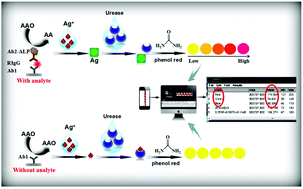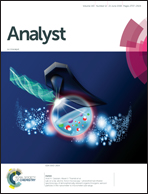A high-resolution colorimetric immunoassay platform realized by coupling enzymatic multicolor generation with smartphone readout
Abstract
A high-resolution colorimetric immunoassay platform has been developed based on enzyme-catalyzed multicolor generation and smartphone-assisted signal readout. The multi-color generation is accomplished in this system through the urease-catalyzed urea hydrolysis-induced color change of the pH indicator phenol red, from yellow to orange to red over pH 6.6 to 8.0. The color change is easily tailored by controlling the urease activity via the inhibitor silver ion (Ag+), the amount of which is in turn adjusted by alkaline phosphatase (ALP)-catalyzed ascorbic acid (AA) production. An ALP-linked colorimetric immunoassay is readily realized based on the above urease catalyzed multicolor generation system. Under optimal conditions, a limit of detection (LOD) of 1.73 ng mL−1 and a dynamic range from 0 to 18 ng mL−1 are achieved with rabbit IgG as a model analyte. A colored picture for each test is directly taken using a smartphone and then quantitatively analyzed with the free software ImageJ, eliminating the use of expensive and desktop equipment. The dose-dependent multicolor display is easier to distinguish with the naked eye for qualitative or semiquantitative detection over the traditional one-color system. The developed immunoassay scheme provides a promising platform for on-site testing or applications in resource-poor areas.



 Please wait while we load your content...
Please wait while we load your content...